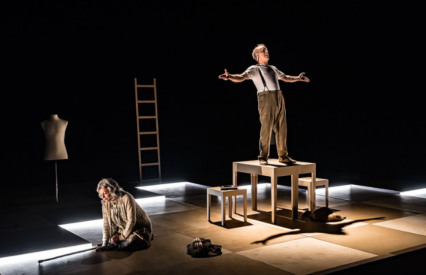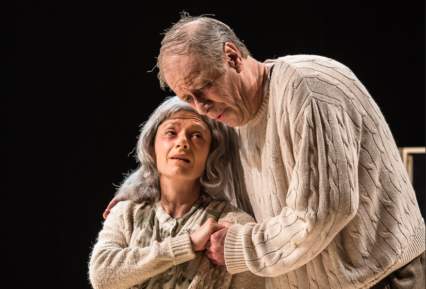Linda Christmas shares her thoughts on Y Tŵr, a Welsh-language opera based on Gwenlyn Parry’s acclaimed play of the same name. Music Theatre Wales and Theatr Genedlaethol Cymru’s collaborative production for the opera’s 2017 premiere has been made available to watch online as part of the Theatr Gen Eto programme.
Music Theatre Wales and Theatr Genedlaethol Cymru (The National Theatre of Wales) assembled a distinguished quartet (composer, librettist, director and set designer), all prize winners in their field, to turn this famous play into a chamber opera. It is a bold venture with a daring choice of subject: two ordinary people, living textbook-ordinary lives. Opera, in its four-hundred-year lifespan, prefers to eschew the everyday in favour of fantasy: gods and giants, the escapades of grandees and star-crossed lovers caught up in politics. There was a short period at the end of the nineteenth century when composers such as Puccini attempted realism by using characters drawn from everyday life, but the plots favoured melodrama and often violence. Contemporary opera likes much the same; ordinary people in unusual circumstances ending in death: flowers that kill; infatuation with an ice-skater that offers an ice rink as the back-drop to murder; the dark side of the internet woven into a police procedural.
There are no unusual circumstances in Y Tŵr: the story is resolutely humdrum.
Parry’s play and the opera offer scenes from the lives of two unnamed people, one male, one female. In Act One they are childhood sweethearts. She is vibrant, eager to embrace life; he is more cautious, a vanilla character dreaming of owning a motorbike. It’s hard to see why she is attracted to him. She gets pregnant and that ends her dreams of a life different from that of her mother. In Act Two they endure a mid-life crisis. He, brown suited and browned off with his unsatisfying job; she, having an affair with his boss which ensures he keeps his job. Disillusioned, they yearn for a visit from their son. In Act Three they sink into empty old age, once again hoping for a visit from their son and his family. She’s ended up like her mother, eking out an existence, full of pretence about holidays that never come.
Can opera, soaked in fantasy, melodrama and violence, handle their mundane lives? It can because Y Tŵr comes with a respectable label: The Theatre of the Absurd. Parry has been compared to Beckett, Ionesco and Pinter. These writers express the view that most human existence lacks meaning or purpose and offers scant communication. It is our task to bear this with dignity, discarding illusions and acknowledging that there are no easy solutions. Y Tŵr’s couple is trapped. They are so codependent (not the first time Perry has used this theme) that it is impossible to break away. He accepts this earlier. She takes longer to swap hope for acceptance. Indeed, she yearns for freedom in a recurring dream in which she tries to capture a butterfly but can only do so by tearing skin. That would be too painful. It is a remarkable image. The opera is packaged with such tropes. There is the recurring sound of a train; the first time it is heard it is a welcome sound, signalling arrival and excitement, but by the end it heralds departures and tears.
To complement the tropes there are symbols: the tower, represented on stage by a vertical ladder, is life’s journey; the three rooms, referred to obliquely, are youth, middle age and old age; the set, designed by Samal Blak, is simple and symmetrical, each side of the stage containing a dressing table, one for her and one for him. The two sit at their tables and change and age between the acts, before our eyes. At the foot of each table lies an array of deliberately placed objects. The objects are a nod towards Vanitas, a sub-genre of still life painting, popular in the seventeenth century. These paintings were designed to remind us that nothing lasts, not material possessions nor worldly pursuits and that we cannot avoid decay and death; there are fruits and flowers which both easily wither to remind us of our mortality. Interestingly, there are more objects on the female side because it is the female in this opera who has the greater appetite for worldly pleasure. By the third act, all of the objects have disappeared.
This opera is sobering and it is apposite. It may have been written in the 70s, and premiered pre-Covid, but watching now when, for the past year, our lives have shrunk and we have been forced to think about priorities, makes it all the more moving.
The libretto, edited from the play and adapted by Gwyneth Glyn, is commendable. It does not shy from the suitably banal. There are lines such as, ‘What will you have for supper?’ and ‘Where’s my newspaper?’, but for the most part the libretto is truly poetic. We know the Welsh language sounds great when sung, but listening to it sung operatically is a new experience (for those who do not speak Welsh, this is no different from, say, listening to Janacek in Czech). Of the two singers, soprano Caryl Hughes is exceptional throughout and baritone Gwion Thomas comes into his own in the middle act.
The poetic libretto has inspired the composer, Guto Puw. The first act’s music could be said to contain overactive orchestral writing, but it could also be said to represent the mind of the teenager, the whirl of youth; the music slows in the middle act and slows again in the third act, using more of the lower register. Like most new works, there is a concentration on wind and percussion, and the strings are often used to produce dog-whistle dissonance which is unnecessary and uncomfortable. The composer is at his best with wind instruments; they provide the opera’s memorable moments. The first comes when the girl relates her dream about catching the butterfly (0:17:59), another when the couple are decorating their home (1:18:00). The best moment is even hum-able; based on a Welsh folk song, ‘Lisa Lan’, the words echo the opera’s theme: ‘We’ll go up, you and me, Together, hand in hand. We’ll go up, you and me, No regrets, hand in hand’ (0:24:11) The music from here through to the end of Act One offers a rare orchestral moment, successful dramatically even without voices.
The opera has not been mounted since its premiere in 2017. Such is the fate of most new works: there is little or no legacy planning and therefore no opportunity for improvements. New operas are the ultimate disposable objects. Putting Y Tŵr on YouTube helps to assuage this unacceptable practice. The version available is an archive video, made for company records.
Michael McCarthy, artistic director of MTW and director of this production explains: ‘Streaming is a massive issue for a company of our size and income – we cannot include license to stream into our contracts with singers and musicians. The only reason Y Tŵr is happening is because it is being done during the coronavirus pandemic (we arranged this last May) and everyone is willing to accept the same, very small fee, and we are doing it together with Theatr Genedlaethol Cymru – sharing the cost 50/50.“ Thank you to all is appropriate.
To watch Y Tŵr, visit Theatr Genedlaethol Cymru’s YouTube channel. To find out more about the Theatr Gen Eto programme, visit Theatr Genedlaethol Cymru’s website.
Linda Christmas has been an opera devotee for fifty years and has been supporting contemporary opera for ten years.













